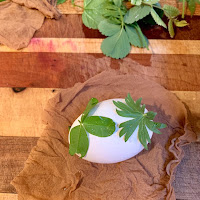Transitional Kindergarten: Spring Flowers
In this lesson TK students were introduced to two different art media: watercolor and oil pastel. Students explored the difference between watercolor (wet medium), and oil pastel (dry medium). Students noticed that the wet medium spreads and bleeds, on the contrary, the dry medium does not. Students painted a large paper flower, experimenting with each of the two media. Students were also introduced to the art element of texture. They placed green paper over textured surfaces, and rubbed with crayons to make the texture appear on the paper. Students cut leaves and stems out of the green texture paper to complete their spring flower piece.Kindergarten: Oil Pastel Flower Vase Still-Life
There are crayons... and then there are pastels! In this project, students were introduced to the American photorealist Ben Schonzeit. Students practiced flower drawing techniques. While depicting the flowers and vases on a large scale, students also picked up basic oil pastel skills - learning how to blend by layering the intense, mixable pastel colors, shading to achieve light and dark, and using their fingers as a tool. A layered, three-dimensional effect was also achieved with the addition of hand made paper petals.Oil pastels were created in 1920 in Japan as a means of introducing Western art education to children. While not a fine arts medium when it was first produced, it was an immediate commercial success and soon after, artists such as Picasso began using oil pastels as a recognized art medium.
1st GRADE: Drawing Local Birds
Project Based Learning and Art Integrations are approaches to teaching in which students construct and demonstrate understanding through an art form. Students engage in a creative process, which connects an art form and another subject area, and meets evolving objectives in both.The "drawing local birds" lesson connects with the first grade PBL driving question: "Why should we care about Creekside marsh?" First grade students went on nature walks to observe animals which inhabit Creekside marsh area. Students observed, charted, and identified birds. In art class students were introduced to David Allen Sibley, American ornithologist. He is the author and illustrator of "The Sibley Guide to Birds" considered by many to be the most comprehensive guide for North American field bird identification.
During a directed sketching lesson students were guided through a series of sketching check-points, to capture the position and gesture of a bird and it's distinctive features, such as, beak, legs, tail and wing feathers. After the intro sketching lesson,
2nd GRADE: Peruvian Folk Art, Arpilleras
Arpilleras or "cuadros" are exquisitely colorful, detailed, hand-sewn, three dimensional textile pictures. Arpilleras illustrate the stories of the lives of the women of the"pueblo jovenes"of Lima, Peru and provide essential income for their families. The arpilleras tell stories of planting and harvesting potatoes, tomatoes, cabbages, grapes, corn; stories of spinning and weaving wool; stories of country life, of tending llamas, alpacas, sheep and goats; stories of weddings and fiestas.
Students picked a primary or secondary color as the main color for their arpilleras. Using white in addition to the main color, students learned to mix tints, from dark to light to create a sense of space to depict the Andes Mountains. Students were introduced to the concept of complementary colors to achieve effective color contrast and vibrancy between the hills and the Peruvian houses and other details. Students folded the houses for their arpilleras in an origami style. Some students experimented folding small and smaller houses to convey perspective. Students created their own narratives adding llamas, alpacas, flowers, etc. to their arpilleras.
3rd GRADE: Basket Weaving
The basket weaving projects connects with the third grade Native American studies. California Natives wove baskets to gather, process, cook and eat acorns. The Acorns were the most important food source from the oak trees, which used to grow all over California. Students were introduced to the two most basic basket-weaving techniques: 1. Twined and plaited basketry, 2. coiled basketry.
Students used flat reeds to plate and weave the bases of their baskets. Using round reeds and raffia, students practiced to twine to weave the wall structure of their baskets. Students added color and texture accents with bead work. To complete their baskets students explored different rim finishes.
Students used flat reeds to plate and weave the bases of their baskets. Using round reeds and raffia, students practiced to twine to weave the wall structure of their baskets. Students added color and texture accents with bead work. To complete their baskets students explored different rim finishes.
4th GRADE: Australian Aboriginal Bark Painting
Fourth grade students studied Australian Aboriginal Bark Art. Students explored the unique art of Australia’s Aborigines from prehistoric cave art to the paintings of the contemporary artists. Students learned that the Aborigines use art as a way to communicate and a way to tell stories, known as "dreamings." Students were introduced to symbols used in Aboriginal bark paintings and used some of those symbols in their own artwork. In the style of the aboriginal artists, students used a variety of sticks and dowels to apply tempera paint in the distinctive pointillism style.






























